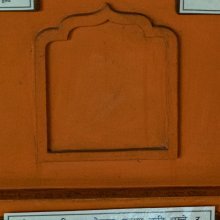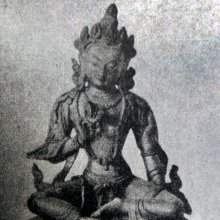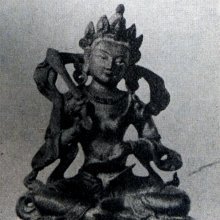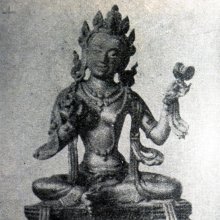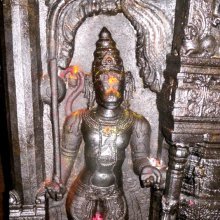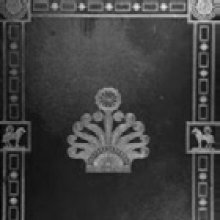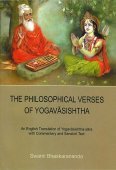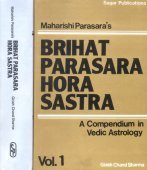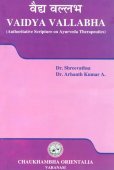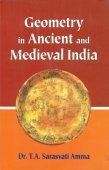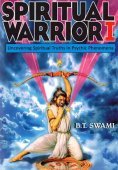Book: 3 definitions
Introduction:
Book means something in Hinduism, Sanskrit. If you want to know the exact meaning, history, etymology or English translation of this term then check out the descriptions on this page. Add your comment or reference to a book if you want to contribute to this summary article.
Images (photo gallery)
(+1510 more images available)
In Hinduism
Shilpashastra (iconography)
Source: Shodhganga: Elements of Art and Architecture in the Trtiyakhanda of the Visnudharmottarapurana (shilpa)Books are associated with Nāsatya (i.e., the twin god Aśvins), whose iconography is described in the Viṣṇudharmottarapurāṇa, an ancient Sanskrit text which (being encyclopedic in nature) deals with a variety of cultural topics such as arts, architecture, music, grammar and astronomy.—According to the Skandapurāṇa Nāsatyas or the twin god Aśvins are the excellent physicians. Since, the Nāsatyas are the physicians of gods, a divine medicinal plant should be placed in their right hands whereas in the left hands of these Gods, two books should be kept. Thus it is clear that the Viṣṇudharmottarapurāṇa offers a great field of knowledge regarding the nuances of Indian art of Image making [e.g., books in the hands of Nāsatya] during 10th–11th century A.D.

Shilpashastra (शिल्पशास्त्र, śilpaśāstra) represents the ancient Indian science (shastra) of creative arts (shilpa) such as sculpture, iconography and painting. Closely related to Vastushastra (architecture), they often share the same literature.
Pancaratra (worship of Nārāyaṇa)
Source: archive.org: Catalogue of Pancaratra Agama TextsThe Book (in Sanskrit: Pustaka) represents one of the various symbols given to initiates after the abhiṣeka-rite, as discussed in the tenth chapter of the Naradiya-Samhita: a Pancaratra document comprising over 3000 verses in 30 chapters presenting in a narrative framework the teachings of Narada to Gautama, dealing primarily with modes of worship and festivals.—Accordingly, Gautama wants to hear details concerning the qualifying abhiṣeka-bath that admits an initiate to deśika-status. [...] One type of abhiṣeka-rite requires only one pot (kalaśa) to be used, at the conclusion of which bathing ceremony the candidate is given the symbols of his new office—[e.g., an pustaka or book]—along with a charge from his preceptor to pursue his duties (21-32). The initiate, in turn, honors this preceptor in all appropriate ways (33-37).

Pancaratra (पाञ्चरात्र, pāñcarātra) represents a tradition of Hinduism where Narayana is revered and worshipped. Closeley related to Vaishnavism, the Pancaratra literature includes various Agamas and tantras incorporating many Vaishnava philosophies.
Languages of India and abroad
Nepali dictionary
Source: unoes: Nepali-English DictionaryBook is another spelling for बुक [buka].—n. 1. booking; 2. book;
Nepali is the primary language of the Nepalese people counting almost 20 million native speakers. The country of Nepal is situated in the Himalaya mountain range to the north of India.
See also (Relevant definitions)
Starts with: Bookinee, Booko, Bookoot, Bookut, Bukuva.
Query error!
Full-text (+7313): Pustaka, Bukkara, Buk, Grantha, Pusta, Pariccheda, Pothi, Granthin, Paricchedana, Veda, Adhyaya, Kitaba, Nondani, Smriti, Kamatantra, Khatevahi, Harivamsha, Adhvarakanda, Adhyayana, Adhyapana.
Relevant text
Search found 539 books and stories containing Book, Buk, The book, Books; (plurals include: Books, Buks, The books, Bookses). You can also click to the full overview containing English textual excerpts. Below are direct links for the most relevant articles:
Literature for Children (A Review of Books) < [January 1959]
Reviewers as Matchmakers < [October – December, 2007]
Authors Hunt for Titles < [July – September, 1998]
Manusmriti with the Commentary of Medhatithi (by Ganganatha Jha)
Verse 12.103 < [Section XI - Supremacy of the Veda]
Verse 7.42 < [Section IV - Duties of the King]
Verse 4.30 < [Section VII - Attending upon Guests]
Bhagavad-gita-rahasya (or Karma-yoga Shastra) (by Bhalchandra Sitaram Sukthankar)
Lord Jhulelal: An Analytical Study (by Thakkar Harish Gopalji)
Part 6.1 - Dariyalal in the Gujarati language < [Chapter 2 - Literature Review]
Part 5.2 - Literature Reviews (Introduction) < [Chapter 2 - Literature Review]
Part 29 - Lord Jhulelal, Life and Teachings < [Chapter 2 - Literature Review]
Satirical works of Kshemendra (study) (by Arpana Devi)
8.3. Summary of The Battle of the Book < [Chapter 1 - Introduction]
4. Educational Life < [Chapter 2 - Kṣemendra: His Life and Works]
9.9. Summary of the Bahurupī (1926) < [Chapter 1 - Introduction]
Buddhist Education in Thailand (critical study) (by Smitthai Aphiwatamonkul)
7.1. The Phrapariyattidhamma: Study in the Section of Nakdham Course < [Chapter 2 - The Thai Sangha System of Education]
7.2. The Phrapariyattidhamma: Study in the Form of Pali Course < [Chapter 2 - The Thai Sangha System of Education]
6. Roles of Buddhist Universities towards the Thai Society < [Chapter 3 - The Impact of Buddhist Education on Thai Sangha]
Related products
(+57 more products available)
